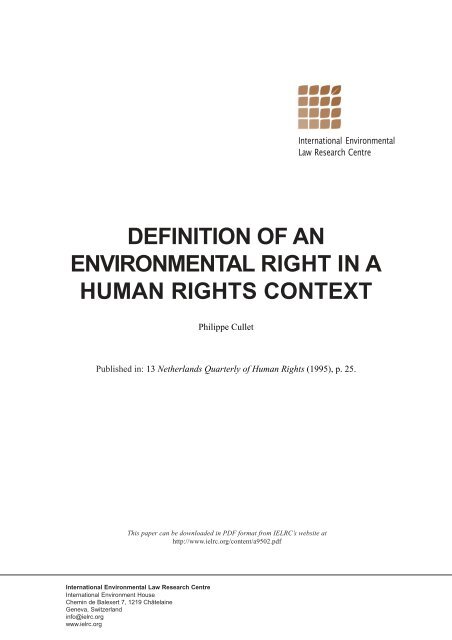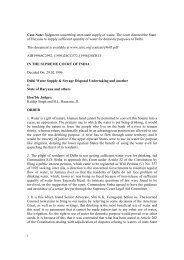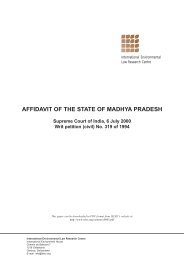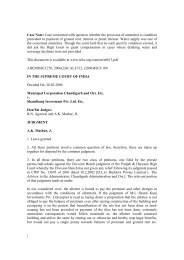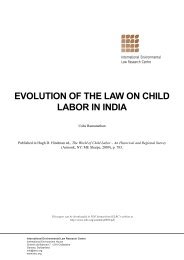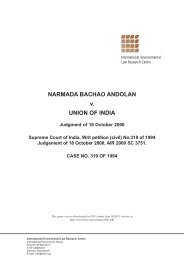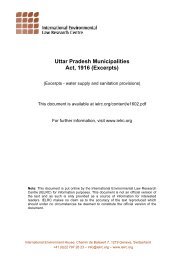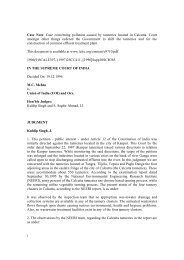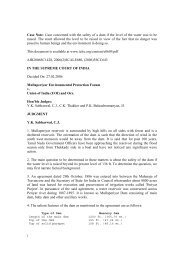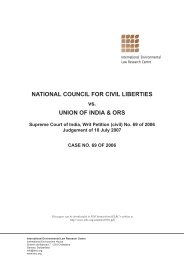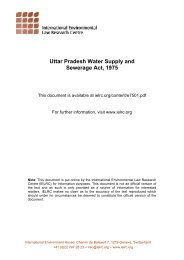Definition of an Environmental Right in a Human Rights Context
Definition of an Environmental Right in a Human Rights Context
Definition of an Environmental Right in a Human Rights Context
Create successful ePaper yourself
Turn your PDF publications into a flip-book with our unique Google optimized e-Paper software.
NQH1R 1 / 1995procedural rights only <strong>in</strong>tervene at the level <strong>of</strong> the implementation <strong>of</strong> the claim <strong>an</strong>d shallbe tackled <strong>in</strong> a later section.A. Foundation <strong>of</strong> the ClaimOn a factual level, it has already become apparent that preservation, conservation <strong>an</strong>drestoration <strong>of</strong> the environment are a necessary <strong>an</strong>d <strong>in</strong>tegral part <strong>of</strong> the enjoyment <strong>of</strong>, <strong>in</strong>teralia, the rights to health, to food <strong>an</strong>d to life <strong>in</strong>clud<strong>in</strong>g a decent quality <strong>of</strong> life.' The closel<strong>in</strong>k with these rights clearly shows that a right to environment c<strong>an</strong> easily be <strong>in</strong>corporated<strong>in</strong>to the core <strong>of</strong> the hum<strong>an</strong> rights protection whose ultimate purpose is the bloom<strong>in</strong>g <strong>of</strong>the personality <strong>of</strong> all hum<strong>an</strong> be<strong>in</strong>gs <strong>in</strong> dignity.'In accord<strong>an</strong>ce with <strong>in</strong>ternational law theory, all hum<strong>an</strong> rights represent universalclaims necessary to gr<strong>an</strong>t every hum<strong>an</strong> be<strong>in</strong>g a decent life that are part <strong>of</strong> the core moralcodes common to all societies.' International hum<strong>an</strong> rights have been based, s<strong>in</strong>ce their<strong>in</strong>ception, on this premise that should not be seen as <strong>an</strong>other m<strong>an</strong>ifestation <strong>of</strong>imperialism,' but as the recognition that all hum<strong>an</strong> be<strong>in</strong>gs aspire to a life <strong>in</strong> dignity.'The l<strong>in</strong>kage between environmental <strong>an</strong>d hum<strong>an</strong> rights concerns has so far been envisagedmostly <strong>in</strong> terms <strong>of</strong> the protection or conservation <strong>of</strong> a cle<strong>an</strong> or healthy environment forthe benefit <strong>of</strong> <strong>in</strong>dividuals whose conditions <strong>of</strong> life are threatened, e.g. by noisedisturb<strong>an</strong>ces or air pollution aris<strong>in</strong>g from airports or motorways <strong>an</strong>d <strong>in</strong>dustrial pollution.To arrive at a truly universal formulation, a right to environment should also encompassother issues <strong>of</strong> concern to a majority <strong>of</strong> the world's population, <strong>in</strong>clud<strong>in</strong>g access to freshwater <strong>an</strong>d food supplies.The apparently sharp difference between <strong>in</strong>dustry-related pollution seen ma<strong>in</strong>ly as aproblem <strong>of</strong> the North <strong>an</strong>d livelihoods issues perceived as a southern issue prompts someto claim that problems are too divergent <strong>in</strong> North <strong>an</strong>d South countries to be dealt with<strong>in</strong>a s<strong>in</strong>gle framework. This criticism overlooks the fact that m<strong>an</strong>y environmental problemsare not country-specific <strong>an</strong>d that <strong>in</strong>dustrial pollution is <strong>in</strong> most cases experienced <strong>in</strong> aThe special rapporteur on the realization <strong>of</strong> economic, social <strong>an</strong>d cultural rights has identifiedenvironmental degradation as one factor imped<strong>in</strong>g the realization <strong>of</strong> these rights (UN Doc.E/CN.4/Sub.2/1992/16, The Realization <strong>of</strong> Economic, Social <strong>an</strong>d Cultural <strong>Right</strong>s - F<strong>in</strong>al Report Submittedby Mr. D<strong>an</strong>ilo Tirk, Special Rapporteur, at p. 32).2 Kromarek, P., 'Le droit A un environnement quilibr6 et sa<strong>in</strong>, consid6r6 comme un droit de l'homme; samise en oeuvre nationale, europ6enne et <strong>in</strong>ternationale', Introductory report, Europe<strong>an</strong> Conference on theEnvironment <strong>an</strong>d Hum<strong>an</strong> <strong>Right</strong>s, Strasbourg 19-20 J<strong>an</strong>uary 1979, Institute for Europe<strong>an</strong> <strong>Environmental</strong>Policy, London (mimeographed/restricted circulation), at p. 13, quot<strong>in</strong>g Cass<strong>in</strong>.Hoeffe, 0., 'Les droits de l'homme comme pr<strong>in</strong>cipes de l'hum<strong>an</strong>it6 politique', <strong>in</strong>: Pap<strong>in</strong>i, R. (Directionde l'ouvrage), Droits des peuples, droits de l'homme - Paix etjustice sociale <strong>in</strong>ternationale, Le Centurion(Collection droits de l'homme et solidarit6), Paris 1984, at p. 95.Even though the Universal Declaration <strong>of</strong> Hum<strong>an</strong> <strong>Right</strong>s <strong>an</strong>d the two UN Hum<strong>an</strong> <strong>Right</strong>s Coven<strong>an</strong>ts weredrafted by the former colonial countries with<strong>in</strong> a structure <strong>of</strong> <strong>in</strong>ternational law ma<strong>in</strong>ly geared towards theirneeds, most societies have def<strong>in</strong>ed rights <strong>an</strong>d duties on the basis <strong>of</strong> similar notions <strong>of</strong> justice <strong>an</strong>d dignity(see Marks, S.P., 'Emerg<strong>in</strong>g Hum<strong>an</strong> <strong>Right</strong>s: a New Generation for the 1980's?', 33/2 Rutgers L. Rev.,1981, pp. 435-452, at p. 437). However, whereas pr<strong>in</strong>ciples may be universal, local implementation mustbe reserved so as to allow for divergences among hum<strong>an</strong> societies based on historical, geographical orsocial specificities. Besides, the absence <strong>of</strong> formal hierarchy between universal pr<strong>in</strong>ciples does not precludeprioritization <strong>in</strong> practice <strong>in</strong> so far as the specific needs <strong>of</strong> each society are different.This has been repeatedly stated, e.g., <strong>in</strong> the Preamble to the Universal Declaration <strong>of</strong> Hum<strong>an</strong> <strong>Right</strong>s (UNDoc. ST/HR/1/Rev.4 (Vol.1, Part 1)).26He<strong>in</strong>Onl<strong>in</strong>e -- 13 Neth. Q. Hum. Rts. 26 1995
NQHR 1 / 1995categories." The right to environment requires States to refra<strong>in</strong> from activities harmfulto the environment, <strong>an</strong>d to adopt <strong>an</strong>d enforce policies promot<strong>in</strong>g conservation <strong>an</strong>dimprovement <strong>of</strong> the quality <strong>of</strong> the environment.' 2 Secondly, it appears on several countsthat the right is not purely <strong>an</strong> <strong>in</strong>dividual right: one may s<strong>in</strong>gle out the rights <strong>of</strong> futuregenerations whose <strong>in</strong>terests must be taken <strong>in</strong>to account but whose <strong>in</strong>dividual membersc<strong>an</strong>not be identified," or focus on more precise claims relat<strong>in</strong>g <strong>in</strong> particular to displaced<strong>in</strong>digenous peoples fac<strong>in</strong>g the total loss <strong>of</strong> their cultural, social <strong>an</strong>d physical environment.The right to environment thus rem<strong>in</strong>ds us <strong>of</strong> the <strong>in</strong><strong>an</strong>ity <strong>of</strong> a tight separation betweenpositive <strong>an</strong>d negative rights, <strong>in</strong>dividual <strong>an</strong>d collective rights or political <strong>an</strong>d economicproblems, dist<strong>in</strong>ctions that were promoted primarily as political or ideological weaponsdur<strong>in</strong>g the Cold War rather th<strong>an</strong> grounded <strong>in</strong> the nature <strong>of</strong> the rights themselves.The v<strong>an</strong>ish<strong>in</strong>g categorization <strong>of</strong> hum<strong>an</strong> rights leads us to reject <strong>an</strong>y hierarchy <strong>in</strong>theory <strong>in</strong>s<strong>of</strong>ar as all the rights we <strong>in</strong>clude as hum<strong>an</strong> rights are fundamental rights, <strong>of</strong>which none c<strong>an</strong> be held to be <strong>in</strong>tr<strong>in</strong>sically superior given their pervasive<strong>in</strong>terdependence." The globalization <strong>of</strong> challenges tends <strong>in</strong>deed to show clearly that allbiological as well as economic processes are <strong>in</strong>terrelated <strong>an</strong>d must be dealt with<strong>in</strong> a s<strong>in</strong>gleframework." However, the implementation <strong>of</strong> all hum<strong>an</strong> rights c<strong>an</strong>not be achieved atonce given the limited availability <strong>of</strong> resources. Each State will have to promote someareas <strong>in</strong> priority accord<strong>in</strong>g to the special needs <strong>of</strong> the country but this should never bedone at the expense <strong>of</strong> other rights, only <strong>in</strong> parallel."C. Formulation <strong>of</strong> the <strong>Right</strong>At this juncture, the focus must be put on the term<strong>in</strong>ology used to def<strong>in</strong>e a right toenvironment <strong>in</strong> legal <strong>in</strong>struments. Most <strong>of</strong> the <strong>in</strong>struments embody<strong>in</strong>g this right haveeither qualified the word environment," or focused the attention on some particular"1 Pathak, R.S., 'The Hum<strong>an</strong> <strong>Right</strong>s System as a Conceptual Framework for <strong>Environmental</strong> Law', <strong>in</strong>: BrownWeiss, E. (ed.), <strong>Environmental</strong> Ch<strong>an</strong>ge <strong>an</strong>d International Law - New Challenges <strong>an</strong>d Dimensions, UNUniversity Press, Tokyo 1992, ; pp. 205-243.12 Besides, states must ensure that people are protected aga<strong>in</strong>st environmental risk generated either bygovernmental or private agencies. See Nickel, J.W., 'The Hum<strong>an</strong> <strong>Right</strong> to a Safe Environment:Philosophical Perspectives on its Scope <strong>an</strong>d Justification', 18/1 Yale J. <strong>of</strong> Int'l L. 1993, pp. 282-295, atp. 286.13 Shutk<strong>in</strong>, W.A., 'International Hum<strong>an</strong> <strong>Right</strong>s Law <strong>an</strong>d the Earth: The Protection <strong>of</strong> Indigenous Peoples <strong>an</strong>dthe Environment, 31/3 Virg<strong>in</strong>ia J. <strong>of</strong> Int'lL. 1991, pp. 479-511, at p. 504.14 See, e.g. Article 5 <strong>of</strong> the Vienna Declaration <strong>an</strong>d Programme <strong>of</strong> Action <strong>of</strong> 25 June 1993 (UN Doc.A/CONF. 157/24 (Part I), Report <strong>of</strong> the World Conference on Hum<strong>an</strong> <strong>Right</strong>s).1sIt is fairly signific<strong>an</strong>t that recommendations <strong>in</strong>cluded <strong>in</strong> the f<strong>in</strong>al report <strong>of</strong> the Special Rapporteur onhum<strong>an</strong> rights <strong>an</strong>d the environment stress <strong>in</strong> effect that all UN bodies deal<strong>in</strong>g with hum<strong>an</strong> rights issuesshould now strive to <strong>in</strong>clude environmental issues <strong>in</strong> their framework <strong>of</strong> <strong>an</strong>alysis. The report thusacknowledges that the different bodies <strong>in</strong>stituted under different treaties <strong>in</strong> the name <strong>of</strong> separate categories<strong>of</strong> rights now have to deal with a common set <strong>of</strong> issues <strong>an</strong>d eventually will have to adopt a commonresponse to common threats (see UN Doc. E/CN.4/Sub.2/1994/9, 6 July 1994, Hum<strong>an</strong> <strong>Right</strong>s <strong>an</strong>d theEnvironment - F<strong>in</strong>al report prepared by Mrs Fatma Zohra Ksent<strong>in</strong>i, Special Rapporteur, pp. 62-63).16 Most scholars <strong>an</strong>d governments now accept that the trade-<strong>of</strong>f between either civil <strong>an</strong>d political rights <strong>an</strong>deconomic <strong>an</strong>d social rights (classical argument that economic development was to be achieved first beforecar<strong>in</strong>g for economic <strong>an</strong>d social rights) on the reverse argument (former World B<strong>an</strong>k claim that theimplementation <strong>of</strong> political rights was not l<strong>in</strong>ked to the successful realization <strong>of</strong> economic <strong>an</strong>d social rights)was not conducive to the promotion <strong>of</strong> either set <strong>of</strong> rights <strong>in</strong> the long term.17 On the assumption that 'environment' is neutral <strong>an</strong>d needs qualification even though it should be obviousthat no one is claim<strong>in</strong>g a right to a degraded environment.28He<strong>in</strong>Onl<strong>in</strong>e -- 13 Neth. Q. Hum. Rts. 28 1995
Cullet / <strong>Def<strong>in</strong>ition</strong> <strong>of</strong> <strong>an</strong> <strong>Environmental</strong> <strong>Right</strong> <strong>in</strong> a Hum<strong>an</strong> <strong>Right</strong>s <strong>Context</strong>elements. In most <strong>in</strong>st<strong>an</strong>ces, the right recognized is a right to a healthy or cle<strong>an</strong> environmentor <strong>an</strong> environment conducive to well-be<strong>in</strong>g <strong>an</strong>d higher st<strong>an</strong>dards <strong>of</strong> liv<strong>in</strong>g, all <strong>of</strong> which centreon the quality <strong>of</strong> life <strong>of</strong> the better-<strong>of</strong>f throughout the world." Some bolder formulationsspeak <strong>of</strong> a right to a decent environment encompass<strong>in</strong>g social <strong>an</strong>d cultural aspects that take,e.g. <strong>in</strong>to account the suitability <strong>of</strong> a given environment to <strong>an</strong> <strong>in</strong>dividual or a people accord<strong>in</strong>gto its social <strong>an</strong>d cultural needs <strong>an</strong>d thus acknowledge the <strong>in</strong>terdependence <strong>of</strong> all elements <strong>of</strong>the hum<strong>an</strong> environment." F<strong>in</strong>ally, a number <strong>of</strong> <strong>in</strong>struments recognize the l<strong>in</strong>k between theprotection <strong>of</strong> the environment <strong>an</strong>d development. This was first envisaged <strong>in</strong> a b<strong>in</strong>d<strong>in</strong>g<strong>in</strong>strument <strong>in</strong> the Afric<strong>an</strong> Charter. 2 oTwo different trends c<strong>an</strong> be identified <strong>in</strong> the history <strong>of</strong> these provisions. First, at the UNlevel, the references to a right to environment have become over the last 20 years less <strong>an</strong>dless clear even though a great number <strong>of</strong> <strong>in</strong>struments do acknowledge the relationshipbetween hum<strong>an</strong> rights <strong>an</strong>d environmental protection. 21 Second, conservation <strong>of</strong> theenvironment has become over the years <strong>in</strong>tr<strong>in</strong>sically enmeshed with development. If peoplemay have been able to speak <strong>of</strong> environmental protection for itself at the 1972 StockholmConference on the Hum<strong>an</strong> Environment, everyth<strong>in</strong>g tends to be put today under the head<strong>in</strong>g<strong>of</strong> susta<strong>in</strong>able development that supposedly reflects the <strong>in</strong>tegration <strong>of</strong> developmental <strong>an</strong>denvironmental concerns. 22 The concept <strong>of</strong> susta<strong>in</strong>able development, however welcome itmay be <strong>in</strong> allow<strong>in</strong>g all countries, <strong>of</strong>ficial <strong>an</strong>d private agencies to speak the same l<strong>an</strong>guage <strong>an</strong>dshare the same rhetoric, is not well def<strong>in</strong>ed <strong>an</strong>d clearly ambiguous <strong>in</strong> its orientation. In most<strong>of</strong> the recent documents, what is me<strong>an</strong>t by development is not the comprehensive process<strong>in</strong>volv<strong>in</strong>g social, economic <strong>an</strong>d cultural elements that was outl<strong>in</strong>ed <strong>in</strong> the Declaration on theright to development, but ma<strong>in</strong>ly economic growth.' Moreover, <strong>in</strong> the discussion onsusta<strong>in</strong>able development, economic development tends to take precedence over environmentalprotection." Thus, <strong>in</strong> the Rio Declaration, what is at stake is the relationship betweeneconomic growth <strong>an</strong>d environmental protection rather th<strong>an</strong> development, hum<strong>an</strong> rights <strong>an</strong>dthe environment. The problem is then that economic growth is seen as the first element <strong>in</strong>the relationship between development <strong>an</strong>d environment <strong>an</strong>d that the hum<strong>an</strong> rights dimensionis E.g. Article 11, Additional Protocol to the Americ<strong>an</strong> Convention on Hum<strong>an</strong> <strong>Right</strong>s <strong>in</strong> the Area <strong>of</strong>Economic, Social <strong>an</strong>d Cultural <strong>Right</strong>s - 'Protocol <strong>of</strong> S<strong>an</strong> Salvador' (repr<strong>in</strong>ted <strong>in</strong>: 28 LM 1989, p. 156),<strong>an</strong>d the draft UN Economic Commission for Europe Charter on <strong>Environmental</strong> <strong>Right</strong>s <strong>an</strong>d Obligations,adopted 29-31 October 1990, Pr<strong>in</strong>ciple 1 (UN Doc. ENVWA/R.38, Annex 1).1 Declaration <strong>of</strong> the United Nations Conference on the Hum<strong>an</strong> Environment (the Stockholm Declaration),Pr<strong>in</strong>ciple 1 (UN Doc. A/Conf.48/14/Rev. 1).20 Afric<strong>an</strong> Charter on Hum<strong>an</strong> <strong>an</strong>d Peoples' <strong>Right</strong>s, Article 24 (repr<strong>in</strong>ted <strong>in</strong>: 21 iLM 1982, p. 58).21 Pr<strong>in</strong>ciple 1 <strong>of</strong> the Stockholm Declaration thus appears retroactively one <strong>of</strong> the most boldest formulations(above note 19).E.g. Pr<strong>in</strong>ciple 4 <strong>of</strong> the Rio Declaration on Environment <strong>an</strong>d Development (UN Doc. A/CONF.151126(Vol. 1), Report <strong>of</strong> the UNCED, Rio de J<strong>an</strong>eiro, 3-14 June 1992, Annex I).23 UN General Assembly Resolution 41/128, 4 December 1986, Declaration on the <strong>Right</strong> to Development(UN Doc. ST/HR/1/Rev.4 (Vol.I/Part.2)).2 E.g. Pr<strong>in</strong>ciple 3 <strong>of</strong> the Rio Declaration (above note 22) <strong>an</strong>d Article 11 <strong>of</strong> the Vienna Declaration (abovenote 14). The doctr<strong>in</strong>e <strong>an</strong>d some operational agencies <strong>of</strong> the UN system have come to <strong>an</strong>alyze developmentover time as a comprehensive process whose realization is dependent upon the realization <strong>of</strong> hum<strong>an</strong> rights<strong>an</strong>d environmental protection, <strong>an</strong>d that is not to be primarily based upon economic growth. However, evenwith<strong>in</strong> the UNDP that seems most adv<strong>an</strong>ced <strong>in</strong> this regard, susta<strong>in</strong>able hum<strong>an</strong> development is regarded as'development that not only generates economic growth' but other benefits as well (UN Doc. DP/1994/39,§ 12). Susta<strong>in</strong>able development thus seems to be first associated with growth before tak<strong>in</strong>g <strong>in</strong>to accountthe hum<strong>an</strong> or environmental dimension.29He<strong>in</strong>Onl<strong>in</strong>e -- 13 Neth. Q. Hum. Rts. 29 1995
NQHR 1 / 1995is left aside,' although hum<strong>an</strong> rights should constitute <strong>an</strong> essential me<strong>an</strong>s <strong>an</strong>d end <strong>of</strong>development. 26Another issue <strong>of</strong> concern <strong>in</strong> the determ<strong>in</strong>ation <strong>of</strong> a hum<strong>an</strong> right to environment is thatsome <strong>of</strong> the provisions seem to move away from some <strong>of</strong> the most fundamental elements <strong>of</strong>the hum<strong>an</strong> rights theory. One may thus wonder whether Pr<strong>in</strong>ciple 3 <strong>of</strong> the Rio Declarationgr<strong>an</strong>ts a right to development to States or to <strong>in</strong>dividuals,' <strong>an</strong>d Article 3(4) <strong>of</strong> the ClimateCh<strong>an</strong>ge Convention clearly gr<strong>an</strong>ts States a right to susta<strong>in</strong>able development. 28 Thesedevelopments, whatever their merits, are not welcome <strong>in</strong> the framework <strong>of</strong> a hum<strong>an</strong> rights'<strong>an</strong>alysis as rights <strong>of</strong> States c<strong>an</strong> by def<strong>in</strong>ition not be <strong>in</strong>cluded <strong>in</strong> the framework <strong>of</strong> rights <strong>of</strong><strong>in</strong>dividuals <strong>an</strong>d groups aga<strong>in</strong>st the State.There is however no denial that the emergence <strong>of</strong> global atmospheric challenges call fora reassessment <strong>of</strong> the current structure <strong>of</strong> <strong>in</strong>ternational law. If rights <strong>of</strong> States c<strong>an</strong>not beaccepted <strong>in</strong> a hum<strong>an</strong> rights' context, new mech<strong>an</strong>isms need notwithst<strong>an</strong>d<strong>in</strong>g be devised. Theclassical case <strong>of</strong> citizens compla<strong>in</strong><strong>in</strong>g that their State has not fulfilled its <strong>in</strong>ternationalobligations is not sufficient when problems c<strong>an</strong> be caused <strong>in</strong> one part <strong>of</strong> the world <strong>an</strong>d theireffects felt mostly elsewhere or much later on. <strong>Environmental</strong> <strong>in</strong>struments have started to<strong>in</strong>corporate this dimension <strong>in</strong> some limited <strong>in</strong>st<strong>an</strong>ces. Thus, <strong>in</strong> the UN Economic Commissionfor Europe (UNECE) Impact Assessment Convention, <strong>an</strong>y potentially affected <strong>in</strong>dividual hasa right to participate <strong>in</strong> the assessment <strong>of</strong> certa<strong>in</strong> new activities, be s/he a resident <strong>of</strong> theorig<strong>in</strong> country or not, whereas a <strong>in</strong>dividual right to <strong>in</strong>formation on exist<strong>in</strong>g <strong>in</strong>dustrial risksaris<strong>in</strong>g from <strong>an</strong>y Member State <strong>in</strong> a given area is gr<strong>an</strong>ted <strong>in</strong> the Convention on IndustrialAccidents.2In spite <strong>of</strong> the discrep<strong>an</strong>cy <strong>in</strong> the various formulations <strong>an</strong>d the diverse legal status <strong>of</strong> the<strong>in</strong>struments at stake, all <strong>of</strong> these taken together reveal the existence <strong>of</strong> a basic aspirationaround the world to a global environment conducive to life on earth <strong>an</strong>d a local environmentfree from unacceptable degradation. The fact that the content <strong>of</strong> the right recognized doesdiffer signific<strong>an</strong>tly, particularly between <strong>in</strong>struments <strong>in</strong> the environment-development fieldor hum<strong>an</strong> rights is no bar to <strong>in</strong>ternational law recogniz<strong>in</strong>g environmental protection <strong>an</strong>dconservation as one <strong>of</strong> its fundamental tenets.The formulation <strong>of</strong> the right as a pla<strong>in</strong> 'right to environment' is no more imprecise th<strong>an</strong>a right to a healthy or cle<strong>an</strong> environment as these qualify<strong>in</strong>g adjectives are themselves vague<strong>an</strong>d subject to divergent <strong>in</strong>terpretations. However, the major drawback <strong>of</strong> the healthy, cle<strong>an</strong>or decent environment formulations is that they have been promulgated ma<strong>in</strong>ly by northernersfocus<strong>in</strong>g on a particular set <strong>of</strong> problems closer to them. Thus, if all formulations are broadenough to cover all situations, the history <strong>of</strong> these proposals make them less suitable touncontroversial <strong>in</strong>terpretation. A 'right to environment' thus has the adv<strong>an</strong>tage <strong>of</strong>2 Agenda 21 (UN Doc. A/CONF. 151/26) which outl<strong>in</strong>es <strong>in</strong> detail the policies to adopt for the realization<strong>of</strong> a susta<strong>in</strong>able development hardly mentions the term hum<strong>an</strong> rights even though they form a necessarypart <strong>of</strong> the strategy proposed (see Shelton, D., 'What Happened <strong>in</strong> Rio to Hum<strong>an</strong> <strong>Right</strong>s?', 3 Yb Int'l Env.L. 1992, pp. 75-93).2 See Paul, J.C.N., 'International Development Agencies, Hum<strong>an</strong> <strong>Right</strong>s <strong>an</strong>d Hum<strong>an</strong>e DevelopmentProjects' (Symposium: International Development Agencies (IDAs), Hum<strong>an</strong> <strong>Right</strong>s <strong>an</strong>d <strong>Environmental</strong>Considerations), 17/1 Den. J. Int'l L. & Pol'y 1988, pp. 67-120, at p. 69.27 See Pallemaerts, M., 'International <strong>Environmental</strong> Law From Stockholm to Rio: Back to the Future?', <strong>in</strong>:S<strong>an</strong>ds, P. (ed.), Green<strong>in</strong>g International Law, Earthsc<strong>an</strong>, London 1993, pp. 9-10.2 Article 3(4) <strong>of</strong> the Framework Convention on Climate Ch<strong>an</strong>ge (repr<strong>in</strong>ted <strong>in</strong>: 31 &M 1992, pp. 849-873).2 Article 2(6) <strong>of</strong> the 1991 UNECE Convention on <strong>Environmental</strong> Impact Assessment <strong>in</strong> a Tr<strong>an</strong>sboundary<strong>Context</strong> <strong>an</strong>d Article 9(1) <strong>of</strong> the 1992 UNECE Convention on the Tr<strong>an</strong>sboundary Effects <strong>of</strong> IndustrialEffects (both repr<strong>in</strong>ted <strong>in</strong>: UN Sales No. E.93.II.E.35, <strong>Environmental</strong> Conventions Elaborated under theAuspices <strong>of</strong> the UNECE, Geneva 1994).30He<strong>in</strong>Onl<strong>in</strong>e -- 13 Neth. Q. Hum. Rts. 30 1995
Cullet / <strong>Def<strong>in</strong>ition</strong> <strong>of</strong> <strong>an</strong> <strong>Environmental</strong> <strong>Right</strong> <strong>in</strong> a Hum<strong>an</strong> <strong>Right</strong>s Contexrepresent<strong>in</strong>g a less biased formulation while recogniz<strong>in</strong>g that the contents <strong>of</strong> the right arelikely to evolve very rapidly as new environmental problems emerge.It rema<strong>in</strong>s to be noted that <strong>in</strong> the future, further developments may be expected <strong>in</strong> theUN arena as a set <strong>of</strong> draft pr<strong>in</strong>ciples on hum<strong>an</strong> rights <strong>an</strong>d the environment will be put on theagenda <strong>of</strong> the Commission on Hum<strong>an</strong> <strong>Right</strong>s as <strong>of</strong> 1995 <strong>an</strong>d may eventually come to beconsidered <strong>in</strong> the General Assembly.o In its current form the draft is quite comprehensive<strong>in</strong> that it <strong>in</strong>cludes a proposed fully-fledged right, goes on to assert some <strong>of</strong> the l<strong>in</strong>kages thatc<strong>an</strong> be made between environmental protection <strong>an</strong>d hum<strong>an</strong> rights already <strong>in</strong>cluded <strong>in</strong> one <strong>of</strong>the coven<strong>an</strong>ts <strong>an</strong>d adds a section on procedures that will be necessary to make the right areality.II Contents <strong>of</strong> a <strong>Right</strong> to EnvironmentThe recognition <strong>of</strong> a subst<strong>an</strong>tive right is still fraught with controversy <strong>in</strong> some quarters asit br<strong>in</strong>gs a number <strong>of</strong> new <strong>an</strong>d challeng<strong>in</strong>g elements to the hum<strong>an</strong> rights theory. Firstly, itshould take <strong>in</strong>to account the need to preserve the very existence <strong>of</strong> life on earth necessaryfor hum<strong>an</strong>k<strong>in</strong>d's survival, <strong>an</strong>d as a second step, ensure that the conditions <strong>of</strong> life providedto hum<strong>an</strong>s are conducive to a decent quality <strong>of</strong> life. These two aspects require thepreservation <strong>of</strong> both local ecosystems <strong>an</strong>d livelihoods, <strong>an</strong>d the global equilibria <strong>of</strong> theecosphere.At this juncture, one should recall that the holders <strong>of</strong> a right to environment c<strong>an</strong> neitherclaim a given state <strong>of</strong> the environment, nor a perfect environment (this has never existeds<strong>in</strong>ce hum<strong>an</strong>s appeared on earth), nor a local environment similar to other places <strong>in</strong> the worldas the unequal distribution <strong>of</strong> resources does not allow for the existence <strong>of</strong> equalenvironmental conditions everywhere. Thus, as stated before, the pr<strong>in</strong>ciple must be universal<strong>an</strong>d the application decentralized <strong>an</strong>d responsive to local concerns as <strong>in</strong> most cases,<strong>in</strong>dividuals only feel threatened or concerned when a problem is directly putt<strong>in</strong>g them at risk.A. The Pr<strong>in</strong>ciple <strong>of</strong> SolidarityTo beg<strong>in</strong> with, the contents <strong>of</strong> the right c<strong>an</strong> be looked at through the pr<strong>in</strong>ciple <strong>of</strong> solidaritythat pervades the l<strong>in</strong>k between hum<strong>an</strong> rights <strong>an</strong>d environmental protection. In hum<strong>an</strong> rights<strong>in</strong>struments, the existence <strong>of</strong> a supportive national <strong>an</strong>d <strong>in</strong>ternational social framework hasalready been recognized as necessary for the realization <strong>of</strong> the rights." In the environmentdevelopmentfields, the solidarity dimension has been prom<strong>in</strong>ent <strong>in</strong> the susta<strong>in</strong>abledevelopment debate s<strong>in</strong>ce the Bruntl<strong>an</strong>d report put so much emphasis on the concept <strong>of</strong> <strong>in</strong>tra<strong>an</strong>d<strong>in</strong>ter-generational equity. Susta<strong>in</strong>able development as expounded <strong>in</strong> Agenda 21 is alsoclearly based upon the idea that nations must recognize the community <strong>of</strong> <strong>in</strong>terests unit<strong>in</strong>ghum<strong>an</strong>ity, that calls <strong>in</strong> turn, e.g. for the richer countries to pay for the 'agreed <strong>in</strong>crementalcosts' <strong>of</strong> activities designed to implement the pr<strong>in</strong>ciples <strong>of</strong> susta<strong>in</strong>able development that willenh<strong>an</strong>ce not only local but global conditions <strong>of</strong> life. 3With regard to a right to environment, the solidarity at stake draws upon these differentaspects. The common good that is thereby protected is multi-faceted. Some problems, like30 F<strong>in</strong>al report on hum<strong>an</strong> rights <strong>an</strong>d the environment at Annex I (above note 15).31 Article 28 <strong>of</strong> the Universal Declaration <strong>of</strong> Hum<strong>an</strong> <strong>Right</strong>s <strong>an</strong>d Articles 2(2) & 3(1) <strong>of</strong> the Declaration onthe <strong>Right</strong> to Development (above notes 5 <strong>an</strong>d 23).32 See World Commission on Environment <strong>an</strong>d Development (G.H. Bruntl<strong>an</strong>d, chairperson), Our CommonFuture, OUP, Oxford 1987.3 See Chapter 33.14 <strong>of</strong> Agenda 21 (UN Doc. A/CONF.151/26 (Vol. III)).31He<strong>in</strong>Onl<strong>in</strong>e -- 13 Neth. Q. Hum. Rts. 31 1995
NQIlR 1 / 1995atmospheric pollution, that may not be the most daunt<strong>in</strong>g today are to be solved through<strong>in</strong>ternational cooperation while a number <strong>of</strong> other problems, though faced everywhere <strong>in</strong> asimilar form (e.g. availability <strong>of</strong> dr<strong>in</strong>k<strong>in</strong>g water) have to be addressed mostly at the local orregional level. In all cases, cooperation <strong>of</strong> all public <strong>an</strong>d private actors, local <strong>an</strong>d<strong>in</strong>ternational players at stake has to be ensured.The dist<strong>in</strong>ction between addressees <strong>an</strong>d beneficiaries <strong>of</strong> the right disappears, because theonly way to achieve <strong>an</strong> effective implementation <strong>of</strong> the right is to lay a duty on the holders<strong>of</strong> the rights, to participate <strong>in</strong> the enh<strong>an</strong>cement <strong>of</strong> the environment, as their actions c<strong>an</strong> havea signific<strong>an</strong>t impact on the state <strong>of</strong> the environment.' A duty has first to be laid upon all<strong>in</strong>dividuals as their comb<strong>in</strong>ed actions c<strong>an</strong> have a signific<strong>an</strong>t impact. However, this dutyshould extend to private enterprises especially <strong>in</strong> the <strong>in</strong>dustrial sector given theirresponsibility for a greater share <strong>of</strong> total pollution th<strong>an</strong> capitalist States themselves. Theyshould be made accountable either directly or through the State <strong>in</strong> application <strong>of</strong> the pr<strong>in</strong>ciple<strong>of</strong> due diligence. These particulars show that the active participation <strong>of</strong> all actors is aprecondition for <strong>an</strong>y me<strong>an</strong><strong>in</strong>gful implementation <strong>of</strong> the right."sSecondly, hum<strong>an</strong> rights provide a framework associat<strong>in</strong>g problems <strong>an</strong>d solutions witha s<strong>in</strong>gle State, whereas, environmental <strong>in</strong>struments recognized early that some locally createdproblems may have a tr<strong>an</strong>sfrontier impact. Some <strong>of</strong> the latter <strong>in</strong>struments have acknowledgedthat harm is not necessarily caused by the State <strong>in</strong> which the effects are felt <strong>an</strong>d thus allow,however imperfectly, the potentially affected <strong>in</strong>dividuals to <strong>in</strong>fluence decision-mak<strong>in</strong>g <strong>of</strong> thesource-State." In hum<strong>an</strong> rights, the Europe<strong>an</strong> Court on Hum<strong>an</strong> <strong>Right</strong>s has, for <strong>in</strong>st<strong>an</strong>ce,acknowledged that acts <strong>of</strong> a Member State that produce effects outside its territory may stillbe held to fall with<strong>in</strong> the jurisdiction <strong>of</strong> that State. No precedent has been set with regardto tr<strong>an</strong>frontier environmental harm <strong>an</strong>d it is doubtful whether the Court would readily admitthat tr<strong>an</strong>sfrontier air pollution c<strong>an</strong> produce effects that give rise to claims by affected<strong>in</strong>dividuals wherever they reside.Thirdly, the pr<strong>in</strong>ciple <strong>of</strong> solidarity rem<strong>in</strong>ds us that we are dependent, <strong>in</strong> the short <strong>an</strong>dlong run, on the up-keep<strong>in</strong>g <strong>of</strong> life on earth for our survival. We must thus acknowledge thatall biological processes allow<strong>in</strong>g life on earth should be preserved because once destroyed,they c<strong>an</strong>not be recreated <strong>in</strong> a vacuum. Consequently, the underly<strong>in</strong>g philosophy <strong>of</strong> a rightto environment po<strong>in</strong>ts to hum<strong>an</strong>k<strong>in</strong>d's dependence on the existence <strong>of</strong> life on earth <strong>an</strong>d thenecessity to take <strong>in</strong>to account the limited availability <strong>of</strong> some natural resources or the limited3 The recognition <strong>of</strong> duties <strong>in</strong> hum<strong>an</strong> rights <strong>in</strong>struments c<strong>an</strong> be found, e.g. <strong>in</strong> the Afric<strong>an</strong> Charter at Articles27-29, the Universal Declaration <strong>of</strong> Hum<strong>an</strong> <strong>Right</strong>s at Article 29 <strong>an</strong>d the UN Hum<strong>an</strong> <strong>Right</strong>s Coven<strong>an</strong>ts atparagraph 5 <strong>of</strong> their respective preambles. In domestic law, Article 45(1) <strong>of</strong> the Sp<strong>an</strong>ish Constitution <strong>of</strong>29 December 1978 states that '[e]veryone has the right to enjoy <strong>an</strong> environment suitable for thedevelopment <strong>of</strong> the person as well as the duty to preserve it' (reported by Kiss, A.C., 'Concept <strong>an</strong>dPossible Implications <strong>of</strong> the <strong>Right</strong> to Environment', <strong>in</strong>: Mahoney, K.E. & Mahoney, P. (eds.), Hum<strong>an</strong><strong>Right</strong>s <strong>in</strong> the Twenty-first Century - A Global Challenge, Nijh<strong>of</strong>f, Dordrecht/Boston/London 1993, pp.551-559, at p. 556, note 5).3 Cf Koppen, I. & Ladeur. K.-H., '<strong>Environmental</strong> <strong>Right</strong>s', <strong>in</strong>: Cassese, A., Clapham, A. & Weiler, J.(eds.), Hum<strong>an</strong> <strong>Right</strong>s <strong>an</strong>d the Europe<strong>an</strong> Community: the Subst<strong>an</strong>tive Law, Europe<strong>an</strong> Union - the Hum<strong>an</strong><strong>Right</strong>s Challenge, Volume III, Europe<strong>an</strong> University Institute, Florence 1991, pp. 1-50, at p. 24 <strong>an</strong>dNickel, J.W., 'The Hum<strong>an</strong> <strong>Right</strong> to a Safe Environment: Philosophical Perspectives on its Scope <strong>an</strong>dJustification', 18/1 Yale J. <strong>of</strong> Int'l L. 1993, pp. 282-295.3 See, e.g. the 1986 IAEA Convention on Early Notification <strong>of</strong> a Nuclear Accident, Vienna (repr<strong>in</strong>ted <strong>in</strong>:25 1LM 1986, pp. 1370-1376, 1986) or the 1992 UNECE Convention on the Tr<strong>an</strong>sboundary Effects <strong>of</strong>Industrial Effects (above note 28).37 See Europe<strong>an</strong> Court on Hum<strong>an</strong> <strong>Right</strong>s, Drozd & J<strong>an</strong>ousek v. Fr<strong>an</strong>ce & Spa<strong>in</strong>, judgment <strong>of</strong> 26 June 1992,Series A, Vol. 240 (repr<strong>in</strong>ted <strong>in</strong>: 14 Eur. Hum. Rts. Rep. 1992, p. 745).32He<strong>in</strong>Onl<strong>in</strong>e -- 13 Neth. Q. Hum. Rts. 32 1995
Cullet I<strong>Def<strong>in</strong>ition</strong> <strong>of</strong> <strong>an</strong> <strong>Environmental</strong> <strong>Right</strong> <strong>in</strong> a Hwn<strong>an</strong> <strong>Right</strong>s <strong>Context</strong>l<strong>an</strong>d surface capable <strong>of</strong> susta<strong>in</strong><strong>in</strong>g hum<strong>an</strong> life. 38 This approach necessarily takes us beyonda pure l<strong>in</strong>ear approach seek<strong>in</strong>g to preserve the hum<strong>an</strong> environment <strong>an</strong>d to use naturalresources wisely there<strong>in</strong> only to serve the material <strong>in</strong>terests <strong>of</strong> hum<strong>an</strong>ity, <strong>an</strong>d leads to a moreholistic perspective acknowledg<strong>in</strong>g that all hum<strong>an</strong> <strong>in</strong>fluences on the environment willeventually have some sort <strong>of</strong> impact upon hum<strong>an</strong>k<strong>in</strong>d even, for <strong>in</strong>st<strong>an</strong>ce, <strong>in</strong> the case <strong>of</strong> <strong>an</strong>oil spill <strong>in</strong> Antarctica. 3 ' <strong>Environmental</strong> protection is thus understood not only as ame<strong>an</strong><strong>in</strong>gful <strong>in</strong>strument for the realization <strong>of</strong> all hum<strong>an</strong> rights but also as a goal <strong>in</strong> itself. Thisrecognition does not necessarily <strong>in</strong>volve gr<strong>an</strong>t<strong>in</strong>g legal rights to the environment or specificparts <strong>of</strong> it, given that the acknowledgement <strong>of</strong> hum<strong>an</strong>s' dependence on a 'healthy' ecospherewill already come a long way towards satisfy<strong>in</strong>g the claims put forward on behalf <strong>of</strong>nature. 40Lastly, solidarity among groups hav<strong>in</strong>g claims to the same resources must be considered.Intra-generational solidarity becomes, for <strong>in</strong>st<strong>an</strong>ce, relev<strong>an</strong>t when economic developmententails the improvement <strong>of</strong> someone's environment or quality <strong>of</strong> life bal<strong>an</strong>ced by the loss <strong>of</strong>other resources <strong>an</strong>d by deprivation for other people. Bal<strong>an</strong>c<strong>in</strong>g the claims put forth bydifferent groups <strong>of</strong> people should thus be one essential part <strong>of</strong> the development cumenvironmental protection paradigm. The Narmada dams <strong>in</strong> India are a good example <strong>of</strong> aproject putt<strong>in</strong>g to test the <strong>in</strong>ter-group solidarity while show<strong>in</strong>g clearly the <strong>in</strong>tricaterelationship between environment <strong>an</strong>d development. 4 ' At Sardar Sarovar, the stated aim <strong>of</strong>the project is to provide irrigation water to drought-prone areas <strong>of</strong> Gujarat <strong>an</strong>d electricity toall the three States shar<strong>in</strong>g the project. But it may well end up feed<strong>in</strong>g new water-<strong>in</strong>tensive<strong>in</strong>dustries near the ma<strong>in</strong> urb<strong>an</strong> centres without deliver<strong>in</strong>g water to its f<strong>in</strong>al dest<strong>in</strong>ation afterhav<strong>in</strong>g displaced <strong>an</strong> estimated 100,000 people who have to be relocated on new l<strong>an</strong>d that isnot freely available <strong>in</strong> India. Thus, this new apportionment <strong>of</strong> natural resources, whilerequir<strong>in</strong>g the displacement <strong>of</strong> m<strong>an</strong>y rural people <strong>an</strong>d caus<strong>in</strong>g signific<strong>an</strong>t environmentaldegradation may come to benefit the urb<strong>an</strong> dwellers already enjoy<strong>in</strong>g a comparatively higherst<strong>an</strong>dard <strong>of</strong> liv<strong>in</strong>g but not the people <strong>of</strong> the three States at large. Apart from the widerdevelopment <strong>an</strong>d environmental problems associated with this type <strong>of</strong> mega-project, SardarSarovar st<strong>an</strong>ds out clearly as a failure to make all people, or at least the least well-<strong>of</strong>f benefitfrom a development project partly aimed at improv<strong>in</strong>g environmental conditions on a regionalscale. 423 See Roots, E.F., 'Population, "Carry<strong>in</strong>g Capacity", <strong>an</strong>d <strong>Environmental</strong> Processes', <strong>in</strong>: Mahoney, K.E.& Mahoney, P. (eds.), Hum<strong>an</strong> <strong>Right</strong>s <strong>in</strong> the Twenty-first Century - A Global Challenge, Nijh<strong>of</strong>f,Dordrecht/Boston/London 1993, pp. 529-549.39 Nash, R. F., The <strong>Right</strong>s <strong>of</strong>Nature: A History <strong>of</strong><strong>Environmental</strong> Ethics, The University <strong>of</strong> Wiscons<strong>in</strong> Press,London/Madison 1989, at p. 8ff Contra Emmenegger, S. & Tschentscher, A., 'Tak<strong>in</strong>g Nature's <strong>Right</strong>sSeriously: The Long Way to Biocentrism <strong>in</strong> <strong>Environmental</strong> Law', 6 Georgetown Int'lEnvtl. L. Rev. 1994,pp. 545-592, at p. 561.4 Furthermore, it may be very difficult conceptually to <strong>in</strong>clude non-hum<strong>an</strong> rights holders <strong>in</strong> the hum<strong>an</strong> rightstheory, given that it has been moulded s<strong>in</strong>ce its <strong>in</strong>ception <strong>in</strong> a strict <strong>an</strong>thropocentric framework associat<strong>in</strong>gthe existence <strong>of</strong> a right with a correspond<strong>in</strong>g obligation (See, e.g. Rolston, H. III, '<strong>Right</strong>s <strong>an</strong>dResponsibilities on the Home Pl<strong>an</strong>et', 18/1 Yale J. <strong>of</strong> Int'l L. 1993, pp. 251-279, at p. 256ff.).41 The facts surround<strong>in</strong>g the Sardar Sarovar Project are exposed <strong>in</strong>: Morse, B. & Berger, T.R., SardarSarovar: Report <strong>of</strong> the Independent Review, The Independent Review, Resource Futures International Inc.,Ottawa 1992.42 A susta<strong>in</strong>able development process should first <strong>of</strong> all aim at improv<strong>in</strong>g the situation <strong>of</strong> the mostdisadv<strong>an</strong>taged (see Rawls, J., A Theory <strong>of</strong> Justice, Clarendon Press, Oxford 1972).33He<strong>in</strong>Onl<strong>in</strong>e -- 13 Neth. Q. Hum. Rts. 33 1995
NQHR 1 / 1995B. The Pr<strong>in</strong>ciple <strong>of</strong> PreventionPrevention is a card<strong>in</strong>al concept <strong>of</strong> hum<strong>an</strong> rights <strong>an</strong>d environmental protection.<strong>Environmental</strong> law has developed around this central issue that has culm<strong>in</strong>ated <strong>in</strong> theformulation <strong>of</strong> a precautionary approach that seeks to avoid the creation <strong>of</strong> <strong>an</strong>y potentiallyhazardous situation.' 3 It acknowledges that actual damages carry very <strong>of</strong>ten irreversible <strong>an</strong>dunpredictable consequences harm<strong>in</strong>g both <strong>in</strong>dividuals <strong>an</strong>d collectivities. Precaution <strong>in</strong>cludesavert<strong>in</strong>g further <strong>in</strong>dustrial accidents <strong>an</strong>d build<strong>in</strong>g only <strong>in</strong>stallations whose safety for the local<strong>an</strong>d global environment c<strong>an</strong> be ensured at all times through proper ma<strong>in</strong>ten<strong>an</strong>ce. On a moregeneral level, it requires the formulation <strong>of</strong> <strong>in</strong>tegrated policies tak<strong>in</strong>g account <strong>of</strong> economic,social <strong>an</strong>d cultural factors <strong>in</strong> the long-term to avoid such dramatic problems asdesertification, waterlogg<strong>in</strong>g <strong>an</strong>d sal<strong>in</strong>ization <strong>of</strong> the water table or ch<strong>an</strong>ges <strong>in</strong> themicroclimates <strong>an</strong>d global weather patterns.International hum<strong>an</strong> rights law is also built on the premise that <strong>an</strong>y violation <strong>of</strong> hum<strong>an</strong>rights should be averted. However, <strong>in</strong> practice the case law has tended to compensate<strong>in</strong>dividuals for specific violations hav<strong>in</strong>g already taken place <strong>an</strong>d then lay pr<strong>in</strong>ciples aimedat dissuad<strong>in</strong>g all future violations. It has thus <strong>in</strong> most cases not taken action before actualharm takes place. The Strasbourg jurisdiction has nevertheless <strong>in</strong> several <strong>in</strong>st<strong>an</strong>ces acceptedthe claims put forward by 'potential' victims <strong>an</strong>d acknowledged that the Convention may be<strong>in</strong>fr<strong>in</strong>ged when the consequences <strong>of</strong> <strong>an</strong> <strong>in</strong>terference are foreseeable, <strong>an</strong>d <strong>of</strong> a serious <strong>an</strong>dirreparable nature." These developments may certa<strong>in</strong>ly be seen as lay<strong>in</strong>g strong foundationsfor a proper preventive approach to evolve <strong>in</strong> hum<strong>an</strong> rights.To sum up, consideration <strong>of</strong> environmental problems <strong>in</strong> a hum<strong>an</strong> rights frameworkrequires more th<strong>an</strong> what is currently available <strong>in</strong> the case law. To this end, the specificities<strong>of</strong> the precautionary approach should be <strong>in</strong>tegrated <strong>in</strong> the hum<strong>an</strong> rights <strong>an</strong>alysis to allow,<strong>in</strong>ter alia, supervisory org<strong>an</strong>s to take preventive measures, or to stop a potentially harmfulactivity before it gets under way even <strong>in</strong> such cases where the potential threat has not yetbeen scientifically ascerta<strong>in</strong>ed or the causal l<strong>in</strong>k not been formally proven. This stems fromthe need to recognize that environmental harm is potentially very likely to affect a greatnumber <strong>of</strong> <strong>in</strong>dividuals <strong>in</strong> m<strong>an</strong>y countries, <strong>an</strong>d very <strong>of</strong>ten also carries irreversibleconsequences for both hum<strong>an</strong> be<strong>in</strong>gs <strong>an</strong>d life-support systems. This is not to deny that allviolations <strong>of</strong> fundamental rights leave perm<strong>an</strong>ent moral or physical scars, but to acknowledgethe specificities <strong>of</strong> environmental challenges <strong>an</strong>d appreciate the ways through which thel<strong>in</strong>kage <strong>of</strong> environmental <strong>an</strong>d hum<strong>an</strong> rights concerns come to enh<strong>an</strong>ce each other.H ImplementationA. Implementation Mech<strong>an</strong>isms <strong>an</strong>d Existence <strong>of</strong> Hum<strong>an</strong> <strong>Right</strong>sSeveral issues have to be addressed <strong>in</strong> this regard because a number <strong>of</strong> <strong>in</strong>tricate controversieshave arisen. First, some opponents <strong>of</strong> the recognition <strong>of</strong> a right to environment have claimedthat the claim is too wide-r<strong>an</strong>g<strong>in</strong>g, c<strong>an</strong>not be judicially enforced <strong>an</strong>d is thus not a hum<strong>an</strong>4 A def<strong>in</strong>ition c<strong>an</strong>, e.g. be found <strong>in</strong> the Rio Declaration (above note 22) at Pr<strong>in</strong>ciple 15 that reads: 'Wherethere are threats <strong>of</strong> serious or irreversible damage, lack <strong>of</strong> full scientific certa<strong>in</strong>ty shall not be used as areason for postpon<strong>in</strong>g cost-effective measures to prevent environmental degradation.'4 Europe<strong>an</strong> Court on Hum<strong>an</strong> <strong>Right</strong>s, Soer<strong>in</strong>g v. UK, judgment <strong>of</strong> 7 July 1989, Series A, No. 161 (repr<strong>in</strong>ted<strong>in</strong>: 11 Eur. Hum. Rts. Rep., p. 439). See also C<strong>an</strong>gado Tr<strong>in</strong>dade, A.A., 'Co-existence <strong>an</strong>d Co-ord<strong>in</strong>ation<strong>of</strong> Mech<strong>an</strong>isms <strong>of</strong> International Protection <strong>of</strong> Hum<strong>an</strong> <strong>Right</strong>s (at Global <strong>an</strong>d Regional Levels)', 202 Recueildes cours de l'acadimie de droit <strong>in</strong>ternational 1987, pp. 271-296.34He<strong>in</strong>Onl<strong>in</strong>e -- 13 Neth. Q. Hum. Rts. 34 1995
Cullet /<strong>Def<strong>in</strong>ition</strong> <strong>of</strong> <strong>an</strong> <strong>Environmental</strong> <strong>Right</strong> <strong>in</strong> a Hum<strong>an</strong> <strong>Right</strong>s <strong>Context</strong>right. It must first be noted that hum<strong>an</strong> rights are not by themselves confrontational rights.Hence, the possibility to br<strong>in</strong>g a claim to a Court is not a fundamental characteristic <strong>of</strong> aright given that a large part <strong>of</strong> the realization <strong>of</strong> hum<strong>an</strong> rights relates for <strong>in</strong>st<strong>an</strong>ce to domesticpolicy-mak<strong>in</strong>g by States, <strong>an</strong>d some rights may be not or only partially enforceable before atribunal. 45 The existence <strong>of</strong> the right <strong>an</strong>d its implementation <strong>an</strong>d enforcement proceduresshould consequently not be confused."Another reason to dist<strong>in</strong>guish enforcement <strong>an</strong>d existence <strong>of</strong> the norm stems from theformulation <strong>of</strong> hum<strong>an</strong> rights on a universal level. Most rights c<strong>an</strong> be formulated either asobligations <strong>of</strong> fulfilment (the right to food) or obligations <strong>of</strong> abstention (the right to be freefrom hunger) with a similar content <strong>an</strong>d one should thus not exam<strong>in</strong>e only the word<strong>in</strong>g butalso the subst<strong>an</strong>ce <strong>of</strong> the rights. Eventually, justiciability depends on whether a specificme<strong>an</strong><strong>in</strong>g c<strong>an</strong> be attributed <strong>in</strong> a particular case. This needs not depend upon the word<strong>in</strong>g <strong>of</strong>the provision at stake <strong>an</strong>d hum<strong>an</strong> rights courts have already shown their ability to give aspecific content to vaguely worded provisions <strong>an</strong>d should therefore be able to do likewise fora right to environment.' These contentions are supported by the proposition put forth tothe Committee <strong>in</strong>stituted under the Coven<strong>an</strong>t on Economic, Social <strong>an</strong>d Cultural <strong>Right</strong>s todraw <strong>an</strong> optional Protocol that would gr<strong>an</strong>t it the power to exam<strong>in</strong>e specific claims <strong>in</strong> asimilar way to the Committee on Hum<strong>an</strong> <strong>Right</strong>s.4At this juncture, it is worth exam<strong>in</strong><strong>in</strong>g non-judicial implementation mech<strong>an</strong>isms because<strong>of</strong> their signific<strong>an</strong>t impact on the realization <strong>of</strong> all rights. Such mech<strong>an</strong>isms were <strong>in</strong>deedalready pl<strong>an</strong>ned <strong>in</strong> the Universal Declaration that sets out teach<strong>in</strong>g <strong>an</strong>d education <strong>in</strong> hum<strong>an</strong>rights as import<strong>an</strong>t elements towards their universal recognition <strong>an</strong>d application. Besides, <strong>an</strong>umber <strong>of</strong> UN hum<strong>an</strong> rights treaties have <strong>in</strong>stituted a State report procedure that allows thesupervis<strong>in</strong>g body to monitor the progressive implementation <strong>of</strong> the rights <strong>an</strong>d to take note <strong>of</strong><strong>an</strong>y problems faced by Member States <strong>in</strong> this regard. The Committee on Economic, Social<strong>an</strong>d Cultural <strong>Right</strong>s thus requires reports to <strong>in</strong>clude <strong>in</strong>formation on environmental problemsfaced <strong>in</strong> relation to the implementation <strong>of</strong> the rights under review, thereby widen<strong>in</strong>g theirpurview. 9 These reports do not lead to the adoption <strong>of</strong> <strong>an</strong>y b<strong>in</strong>d<strong>in</strong>g <strong>an</strong>d specific decision,but the <strong>of</strong>ficial scrut<strong>in</strong>y by <strong>an</strong> <strong>in</strong>ternational org<strong>an</strong> <strong>of</strong> the hum<strong>an</strong> rights record <strong>of</strong> MemberStates <strong>an</strong>d the publication <strong>of</strong> the reports ensure that States do strive to abide by the provisions<strong>of</strong> the treaty at stake <strong>an</strong>d make the rights me<strong>an</strong><strong>in</strong>gful at home.Mention must be made here <strong>of</strong> the non treaty-based thematic procedures located with<strong>in</strong>the Commission on Hum<strong>an</strong> <strong>Right</strong>s. There have been a number <strong>of</strong> thematic rapporteurs s<strong>in</strong>ce1980 whose m<strong>an</strong>dates have been, broadly speak<strong>in</strong>g, to monitor <strong>an</strong>d report on theimplementation <strong>of</strong> certa<strong>in</strong> <strong>in</strong>ternationally recognized hum<strong>an</strong> rights st<strong>an</strong>dards. Even thoughno st<strong>an</strong>dard exists as yet with regard to the relationship between hum<strong>an</strong> rights <strong>an</strong>d4 Eide, A, 'Realization <strong>of</strong> Social <strong>an</strong>d Economic <strong>Right</strong>s <strong>an</strong>d the M<strong>in</strong>imum Threshold Approach', 10/1-2 Hum.Rts. L.J. 1989, pp. 35-51, at pp. 36-38.4 O'M<strong>an</strong>ique, J., 'Hum<strong>an</strong> <strong>Right</strong>s <strong>an</strong>d Development', 14 Hum. Rts. Q. 1992, pp. 78-103, at p. 86ff47 Kiss, A.C., 'D6f<strong>in</strong>ition et nature juridique d'un droit de 1'homme b l'environnement', <strong>in</strong>: UNESCO,Environnement et droits de l'homme, Kromarek, P. (directrice de publication), UNESCO, Paris 1987, pp.13-28, at pp. 20-21.4 See UN Doc. E/C. 12/1994/12, 9 November 1994, Draft OptionalProtocol Provid<strong>in</strong>g for the Consideration<strong>of</strong> Communications - Report Submitted by Mr. Philip Alston. It must be recalled that the justiciability (<strong>an</strong>dexistence) <strong>of</strong> cultural, economic <strong>an</strong>d social rights has been forcefully contested until recently.49 See The Revised Guidel<strong>in</strong>es Regard<strong>in</strong>g the Form <strong>an</strong>d Contents <strong>of</strong> Reports to be Submitted by States Partiesunder Articles 16 <strong>an</strong>d 17 <strong>of</strong> the International Coven<strong>an</strong>t on Economic, Social <strong>an</strong>d Cultural <strong>Right</strong>s,(Committee on Economic, Social <strong>an</strong>d Cultural <strong>Right</strong>s, Report <strong>of</strong> the 5th session, UN Doc. E/1991/23-E/C.12/1990/ 8 , pp. 88-110). The reports <strong>of</strong> State Parties, <strong>in</strong> particular on Articles 10-12 bear mention <strong>of</strong>these requirements <strong>an</strong>d several <strong>of</strong> them discuss environmental problems under these head<strong>in</strong>gs.35He<strong>in</strong>Onl<strong>in</strong>e -- 13 Neth. Q. Hum. Rts. 35 1995
NQlR 1 / 1995environment, Mrs Ksent<strong>in</strong>i's f<strong>in</strong>al report to the Sub-Commission has recommended theappo<strong>in</strong>tment <strong>of</strong> a thematic rapporteur thereon.e If endorsed by the Commission, the newrapporteur will have the m<strong>an</strong>date <strong>of</strong> exam<strong>in</strong><strong>in</strong>g situations <strong>in</strong> which environmental problemsaffect the realization <strong>of</strong> hum<strong>an</strong> rights <strong>an</strong>d at the same time to promote the adoption <strong>of</strong> a texton hum<strong>an</strong> rights <strong>an</strong>d the environment." The rather novel feature <strong>of</strong> this m<strong>an</strong>date is that itwill draw upon a body <strong>of</strong> st<strong>an</strong>dards developed <strong>in</strong> <strong>an</strong>other field <strong>of</strong> <strong>in</strong>ternational law, i.e.<strong>in</strong>ternational environmental law. It c<strong>an</strong> tentatively be said that this new procedure mayhappen to be especially effective <strong>in</strong> accelerat<strong>in</strong>g the formal recognition <strong>of</strong> the relationshipbetween hum<strong>an</strong> rights <strong>an</strong>d environmental protection through, e.g. a General AssemblyResolution. The rapporteur's role will certa<strong>in</strong>ly be centred on rais<strong>in</strong>g awareness <strong>of</strong> theproblems at stake among governments <strong>an</strong>d upon mak<strong>in</strong>g the relationship a m<strong>an</strong>datory part<strong>of</strong> the hum<strong>an</strong> rights debate accepted by the <strong>in</strong>ternational community.B. Implementation <strong>of</strong> a <strong>Right</strong> to EnvironmentSeveral commentators ma<strong>in</strong>ta<strong>in</strong> that the implementation <strong>of</strong> the right to environment wouldbe best achieved through the advocacy <strong>of</strong> rights to <strong>in</strong>formation, to consultation <strong>in</strong> thedecision-mak<strong>in</strong>g process <strong>an</strong>d to access to courts, revamped <strong>in</strong> <strong>an</strong> environmental sett<strong>in</strong>g.These rights <strong>of</strong>ten referred to as procedural rights are very close <strong>in</strong>deed to their counterpart<strong>in</strong> the civil <strong>an</strong>d political rights context. Others claim that these procedural rights should bedist<strong>in</strong>guished from a subst<strong>an</strong>tive right to environment <strong>an</strong>d exam<strong>in</strong>ed as fully-fledged rights. 52It appears first that access to <strong>in</strong>formation, participation <strong>an</strong>d access to court c<strong>an</strong> have atremendous impact on the realization <strong>of</strong> the right to environment <strong>an</strong>d its effectiveenforcement. They amount to a true democratization <strong>of</strong> environmental decision-mak<strong>in</strong>g bybr<strong>in</strong>g<strong>in</strong>g <strong>in</strong> <strong>in</strong>dividuals <strong>an</strong>d private groups who are usually most affected by pollution, <strong>an</strong>dlimit<strong>in</strong>g the discretionary power <strong>of</strong> decision-makers, by allow<strong>in</strong>g <strong>an</strong> explicit bal<strong>an</strong>c<strong>in</strong>g <strong>of</strong><strong>in</strong>terests between environmental protection <strong>an</strong>d economic needs. In this sense these rights are<strong>in</strong>strumental <strong>in</strong> the implementation <strong>of</strong> the subst<strong>an</strong>tive right. However, <strong>in</strong> practice theseprocedures are mostly used <strong>in</strong> the framework <strong>of</strong> <strong>in</strong>dustrial development or urb<strong>an</strong> problems,<strong>an</strong>d will tend to reflect ma<strong>in</strong>ly concerns about the quality <strong>of</strong> life <strong>of</strong> people, whose lives arenot directly threatened by their physical environment, <strong>an</strong>d who have the f<strong>in</strong><strong>an</strong>cial capacityto v<strong>in</strong>dicate their rights. Besides, the issues at stake reflect more <strong>of</strong>ten th<strong>an</strong> not problems <strong>of</strong>local or personal <strong>in</strong>terest <strong>an</strong>d thus only <strong>of</strong>fer a partial solution to the wider issues at stake."Another school argues that there c<strong>an</strong> be no subst<strong>an</strong>tive right to environment because thequality <strong>of</strong> the environment c<strong>an</strong>not be def<strong>in</strong>ed universally a priori, the norm is too imprecise<strong>an</strong>d the claim is not enforceable.' They thus claim that environmental protection <strong>in</strong> a5 See the f<strong>in</strong>al report on hum<strong>an</strong> rights <strong>an</strong>d the environment at p. 63 (above note 15) <strong>an</strong>d Sub-CommissionResolution 1994/27, Hum<strong>an</strong> <strong>Right</strong>s <strong>an</strong>d the Environment (UN Doc. E/CN.4/1995/2-E/CN.4/Sub.2/1994/56).51 For a comprehensive <strong>an</strong>alysis <strong>of</strong> the special procedures, see Alston, P. (ed.), The United Nations <strong>an</strong>dHum<strong>an</strong> <strong>Right</strong>s - A Critical Appraisal, Clarendon, Oxford 1992, pp. 161 ff.52 See Shelton, D., 'Hum<strong>an</strong> <strong>Right</strong>s, <strong>Environmental</strong> <strong>Right</strong>s <strong>an</strong>d the <strong>Right</strong> to Environment', 28/1 St<strong>an</strong>. J. Int'lL. 1991, pp. 103-138, <strong>an</strong>d UN Doc. E/CN.4/Sub.2/1991/8, 2 August 1991, Hum<strong>an</strong> <strong>Right</strong>s <strong>an</strong>d theEnvironment - Prelim<strong>in</strong>ary Report Prepared by Mrs Fatma Zohra Ksent<strong>in</strong>i, Special Rapporteur.5 Other factors that affect the 'representativity' <strong>of</strong> the claims <strong>in</strong> the same ve<strong>in</strong> <strong>in</strong>clude a lack <strong>of</strong> resourcesor ignor<strong>an</strong>ce <strong>of</strong> the existence <strong>of</strong> the procedure (See UN Doc. A/CONF.157/62/Add.5, at §39).54 H<strong>an</strong>dl, G., 'Hum<strong>an</strong> <strong>Right</strong>s <strong>an</strong>d Protection <strong>of</strong> the Environment: A Mildly "Revisionist" View', <strong>in</strong>: C<strong>an</strong>radoTr<strong>in</strong>dade, A.A. (ed.), Hum<strong>an</strong> <strong>Right</strong>s, Susta<strong>in</strong>able Development <strong>an</strong>d the Environment, InstitutoInterameric<strong>an</strong>o de Derechos Hum<strong>an</strong>os/B<strong>an</strong>co Interameric<strong>an</strong>o de Desarrollo, S<strong>an</strong> Jos6 de CostaRica/Brasilia 1992, pp. 117-142 <strong>an</strong>d Birnie, P.W. & Boyle, A.E., International Law <strong>an</strong>d the Environment,36He<strong>in</strong>Onl<strong>in</strong>e -- 13 Neth. Q. Hum. Rts. 36 1995
Cullet / <strong>Def<strong>in</strong>ition</strong> <strong>of</strong> <strong>an</strong> <strong>Environmental</strong> <strong>Right</strong> <strong>in</strong> a Hum<strong>an</strong> <strong>Right</strong>s <strong>Context</strong>hum<strong>an</strong> rights sett<strong>in</strong>g c<strong>an</strong> only be realized through specific procedural rights as a right toenvironmental <strong>in</strong>formation. Such claims do not appear well-founded on several counts: asstated earlier, neither the imprecision <strong>of</strong> the formulation nor its enforceability bear on thestatus <strong>of</strong> a fundamental right. Secondly, the dichotomy between procedural <strong>an</strong>d subst<strong>an</strong>tiverights is <strong>in</strong>tr<strong>in</strong>sically based on the former arguments that served to dist<strong>in</strong>guish civil <strong>an</strong>dpolitical rights from economic <strong>an</strong>d social rights <strong>an</strong>d must be rejected because it is todaywidely accepted that all rights require positive <strong>an</strong>d negative measures <strong>an</strong>d that all rights c<strong>an</strong>be made justiciable." Besides, procedural rights do not have by themselves <strong>an</strong>y subst<strong>an</strong>tivecontent <strong>an</strong>d would be me<strong>an</strong><strong>in</strong>gless if they were to be entirely cut from material considerationsor would become disguised subst<strong>an</strong>tive rights if they were to <strong>in</strong>clude such considerations.F<strong>in</strong>ally, we consider that procedural rights should more properly be labelled <strong>in</strong>strumentalrights as they give the structural framework necessary for the realization <strong>of</strong> all subst<strong>an</strong>tivefundamental hum<strong>an</strong> rights <strong>an</strong>d not only the right to environment. There is a key differencebetween fundamental <strong>an</strong>d <strong>in</strong>strumental rights <strong>in</strong> that the latter rely on positive law as theirunique formal source whereas fundamental rights are usually deemed to form the very basison which <strong>in</strong>ternational law st<strong>an</strong>ds.It is <strong>in</strong>terest<strong>in</strong>g that the emphasis put on procedural rights stems from developments <strong>in</strong><strong>in</strong>ternational environmental law. This field <strong>of</strong> <strong>in</strong>ternational law has until now developedmostly with<strong>in</strong> the classical context <strong>of</strong> <strong>in</strong>ter-State relations <strong>an</strong>d private parties are usually notgr<strong>an</strong>ted immediate rights.s" However, some recent treaties have <strong>in</strong>cluded specific proceduralobligations to force States to assess the (tr<strong>an</strong>sboundary) environmental impacts <strong>of</strong> theiractivities." Though these environmental law procedures do not gr<strong>an</strong>t the citizens a right torequest the assessment <strong>of</strong> all <strong>in</strong>dustrial projects <strong>an</strong>d are not framed with<strong>in</strong> a hum<strong>an</strong> rightslogic, they are <strong>of</strong> much practical signific<strong>an</strong>ce <strong>in</strong> a world where States are less reluct<strong>an</strong>t toratify b<strong>in</strong>d<strong>in</strong>g obligations <strong>in</strong> the field <strong>of</strong> environmental law th<strong>an</strong> <strong>in</strong> hum<strong>an</strong> rights law.One should nevertheless not overlook the fundamental differences between hum<strong>an</strong> rights<strong>an</strong>d environmental law. The perceived necessity to br<strong>in</strong>g environmental considerations <strong>in</strong>tothe hum<strong>an</strong> rights sphere stems from the need to assert environmental preoccupations as afundamental consideration <strong>an</strong>d to benefit from the more elaborate mach<strong>in</strong>ery <strong>of</strong>fered tocitizens by the hum<strong>an</strong> rights <strong>in</strong>struments. If procedures embodied <strong>in</strong> environmental law<strong>in</strong>struments c<strong>an</strong> have a dramatic impact <strong>in</strong> some specific <strong>an</strong>d mostly technical <strong>in</strong>st<strong>an</strong>ces, afundamental hum<strong>an</strong> rights claim encompasses a much broader set <strong>of</strong> issues. In a sense, thecontents <strong>of</strong> a right to environment embrace fundamentally the whole <strong>of</strong> environmental law<strong>an</strong>d represent the fundamental tenets on which <strong>in</strong>ternational environmental law has been built.C. Case LawIn the preced<strong>in</strong>g sections, the l<strong>in</strong>eaments <strong>of</strong> a right to environment have been outl<strong>in</strong>ed. Yet,consideration has to be given to what has already been achieved <strong>in</strong> practice. Some judicialorg<strong>an</strong>s <strong>in</strong> the field <strong>of</strong> hum<strong>an</strong> rights have striven to <strong>in</strong>terpret some <strong>of</strong> the established rights<strong>in</strong> relation to environmental protection. In this way, environmental conservation evolves <strong>in</strong>toa new <strong>in</strong>terpretative element to rights that were established before the <strong>in</strong>ternationalcommunity discovered environmental protection as <strong>an</strong> area <strong>of</strong> high priority. This representsClarendon, Oxford 1992, chapter 5.5 See Inter-Americ<strong>an</strong> Court on Hum<strong>an</strong> <strong>Right</strong>s, Veldsquez Rodriguez Case, Judgment <strong>of</strong> 29 July 1988, SeriesC No. 4, p. 154.5 Cf Allott, P., Eunomia - A New Order for a New World, OUP, Oxford 1990, chapter 16.5 1991 UNECE Convention on <strong>Environmental</strong> Impact Assessment <strong>in</strong> a Tr<strong>an</strong>sboundary <strong>Context</strong> (above note29).37He<strong>in</strong>Onl<strong>in</strong>e -- 13 Neth. Q. Hum. Rts. 37 1995
NQHR 1 / 1995a first <strong>an</strong>d logical way to <strong>in</strong>troduce environmental considerations <strong>in</strong>to the hum<strong>an</strong> rights debateas rights are widely known to evolve over time accord<strong>in</strong>g to the socio-economic context.However, this approach is strictly limited <strong>in</strong>s<strong>of</strong>ar as environmental concerns c<strong>an</strong> only arisewith the violation <strong>of</strong> <strong>an</strong>other right.In this respect, it is worth look<strong>in</strong>g at the l<strong>in</strong>e <strong>of</strong> thought followed by the Strasbourgorg<strong>an</strong>s, as the l<strong>in</strong>k between environment <strong>an</strong>d hum<strong>an</strong> rights has been on the agenda <strong>of</strong> theCouncil <strong>of</strong> Europe for more th<strong>an</strong> twenty years." In the case law, environmentalconsiderations have been dealt with at the level <strong>of</strong> two ma<strong>in</strong> rights, the right to respect forprivate life, <strong>an</strong>d the right to the peaceful enjoyment <strong>of</strong> one's possessions." The Commissionhas however refused to consider the environment <strong>in</strong> its own right, stat<strong>in</strong>g repeatedly thatneither a right to nature is <strong>in</strong>cluded <strong>in</strong> the Convention nor a right to a peaceful environmentnor the peaceful enjoyment <strong>of</strong> one's possessions <strong>in</strong> a pleas<strong>an</strong>t environment? One shouldnot overlook that a vast number <strong>of</strong> environmentally related applications have <strong>in</strong>volved fairtrial issues under Articles 6 <strong>of</strong> the Convention, but it is signific<strong>an</strong>t that the case law has notdevised <strong>an</strong>y specific pr<strong>in</strong>ciples on environmental protection <strong>an</strong>d these cases c<strong>an</strong> thus be<strong>an</strong>alyzed <strong>in</strong> the wider context <strong>of</strong> Articles 6 <strong>an</strong>d 13.The Commission <strong>an</strong>d Court have nevertheless recognized that environmental protectionrepresents one legitimate aim at restrict<strong>in</strong>g rights conta<strong>in</strong>ed <strong>in</strong> the Convention on the samelevel as other recognized limit<strong>in</strong>g clauses. Thus, environmental policies <strong>of</strong> Member Stateshave been repeatedly upheld aga<strong>in</strong>st the restriction <strong>of</strong> <strong>an</strong>other protected right, 61 but so farStates have not been forced to adopt measures to protect the environment if domesticlegislation is non-existent or <strong>in</strong>sufficient <strong>in</strong> one area.' Consequently, national efforts areapproved but no st<strong>an</strong>dardization <strong>of</strong> norms <strong>in</strong> this field is yet sought. Neither the Court northe Commission have attempted to guide or <strong>in</strong>tervene <strong>in</strong> the economic, energy <strong>an</strong>denvironmental policies <strong>of</strong> States. In the case <strong>of</strong> a newly built nuclear energy pl<strong>an</strong>t they haveonly stated that it was necessary for the well-be<strong>in</strong>g <strong>of</strong> the country, <strong>an</strong>d decided that themonetary compensation awarded to people whose rights, protected <strong>in</strong> the Convention, hadbeen violated by the build<strong>in</strong>g <strong>of</strong> the pl<strong>an</strong>t <strong>an</strong>d its daily operation was sufficient to satisfy therequirements <strong>of</strong> the Convention." In this case, the economic development <strong>an</strong>d well-be<strong>in</strong>g<strong>of</strong> the community at large take precedence over the protection <strong>of</strong> the environment. It thusappears that the Strasbourg case law has acknowledged the existence <strong>of</strong> collective <strong>in</strong>terests,at least at the level <strong>of</strong> one s<strong>in</strong>gle sovereign State. However, it has up to now applied strictly58 See Steiger, H. (Rapporteur for the Work<strong>in</strong>g Group for <strong>Environmental</strong> Law, Bonn), The <strong>Right</strong> to a Hum<strong>an</strong>Environment - Proposal for <strong>an</strong> Additional Protocol to the Europe<strong>an</strong> Hum<strong>an</strong> <strong>Right</strong>s Convention, Beitrigezur Umweltgestaltung A13, Erich Schmidt Verlag, Berl<strong>in</strong> 1973.5 Respectively Articles 8 <strong>an</strong>d 1 Protocol 1 <strong>of</strong> the Europe<strong>an</strong> Convention on Hum<strong>an</strong> <strong>Right</strong>s (Europe<strong>an</strong> TreatySeries Nos 5 & 9).6 See Application No. 9310/81, 47 Decisions & Reports (hereafter D & R) 5, 1986, Rayner v. UK, Decision<strong>of</strong> 16 July 1986 on the admissibility (admissible) <strong>an</strong>d Application No. 7407/76, 5 D & R 161, 1976, X& Y. v. Germ<strong>an</strong>y, Decision <strong>of</strong> 13 May 1976 on the admissibility (<strong>in</strong>admissible).61 E.g. Application No. 11185/84, 42D & R 275, 1985, M. Herrick v. UK, Decision <strong>of</strong> 11 March 1985 onthe admissibility (<strong>in</strong>admissible) <strong>an</strong>d Europe<strong>an</strong> Court on Hum<strong>an</strong> <strong>Right</strong>s, Fred<strong>in</strong> v. Sweden, judgment <strong>of</strong> 18Febrary 1991, Series A, No. 192 (repr<strong>in</strong>ted <strong>in</strong>: 13 Eur. Hum. Rts. Rep., p. 784).6 In Application 13724/88, B. Kjellberg v. Sweden, Decision <strong>of</strong> the Commission as to the Admissibility, 5March 1991 (<strong>in</strong>admissible), <strong>in</strong> which the applic<strong>an</strong>t w<strong>an</strong>ted the Swedish government to take action toprohibit gravel exploitation so as to preserve the environment, the Commission did not explicitly bal<strong>an</strong>ceenvironmental <strong>in</strong>terests aga<strong>in</strong>st the owner's economic <strong>in</strong>terests but simply considered that the exploitationwas lawful <strong>an</strong>d aimed at protect<strong>in</strong>g the rights <strong>of</strong> the pit owners to enjoy their property.63 See Application 13728/88, X v. Fr<strong>an</strong>ce, Decision <strong>of</strong> 17 May 1990 <strong>of</strong> the Commission as to theadmissibility (<strong>in</strong>admissible).38He<strong>in</strong>Onl<strong>in</strong>e -- 13 Neth. Q. Hum. Rts. 38 1995
Cullet / <strong>Def<strong>in</strong>ition</strong> <strong>of</strong> <strong>an</strong> <strong>Environmental</strong> <strong>Right</strong> <strong>in</strong> a Hwn<strong>an</strong> <strong>Right</strong>s <strong>Context</strong>the old adage that what boosts gross national product benefits the community at large,thereby overlook<strong>in</strong>g that improvement <strong>of</strong> the quality <strong>of</strong> life <strong>of</strong> Europe<strong>an</strong> residents will onlybe achieved through economic growth that takes <strong>in</strong>to account the protection <strong>of</strong> theenvironment. 4Secondly, <strong>in</strong> some cases the Strasbourg jurisdiction has found excessive noise toconstitute <strong>an</strong> <strong>in</strong>terference with Article 8 <strong>an</strong>d a breach <strong>of</strong> this right has been found when somenoise level set by the Court is reached. Claims on noise-related issues have been upheldseveral times by the Commission or the Court <strong>an</strong>d constitute the only area <strong>in</strong> which they haveviewed the environment as a positive <strong>in</strong>terpretative element rather th<strong>an</strong> only as <strong>an</strong> authorizedlimitation clause. However, <strong>in</strong> the recent L6pez Ostra case, the Court has acknowledged thatnuis<strong>an</strong>ces caused by a t<strong>an</strong>nery's waste-treatment pl<strong>an</strong>t c<strong>an</strong> amount to a breach <strong>of</strong> Article 8.65This decision bears mention<strong>in</strong>g as the first specific recognition <strong>in</strong> Strasbourg that pollutionc<strong>an</strong> seriously affect <strong>in</strong>dividuals' well-be<strong>in</strong>g <strong>in</strong> such a way as to prevent them from enjoy<strong>in</strong>gthe rights recognized <strong>in</strong> Article 8. By consider<strong>in</strong>g that a violation <strong>of</strong> the Convention c<strong>an</strong>occur even if pollution does not signific<strong>an</strong>tly threaten the health <strong>of</strong> hum<strong>an</strong> be<strong>in</strong>gs, thisdecision may signal a new will<strong>in</strong>gness to consider the impact <strong>of</strong> environmental problemsupon the realization <strong>of</strong> the protected rights. Besides, it entails a further recognition <strong>of</strong> theStates' positive duties <strong>in</strong> the field <strong>of</strong> environmental protection which is a welcomedevelopment <strong>in</strong> the Europe<strong>an</strong> context where a signific<strong>an</strong>t share <strong>of</strong> pollut<strong>in</strong>g activities iscarried out by the private sector.In the end, it must be noted that the scope for further exp<strong>an</strong>sion <strong>of</strong> the case law <strong>in</strong> thecurrent legal framework, <strong>an</strong>d notwithst<strong>an</strong>d<strong>in</strong>g the <strong>in</strong>clusion <strong>of</strong> a proper right to environment,is still immense. Cases <strong>in</strong> which environmental considerations have <strong>in</strong>fluenced a decision areto be found ma<strong>in</strong>ly with<strong>in</strong> the realm <strong>of</strong> physical health problems but the Court has until nowrefused to move further <strong>an</strong>d rule <strong>in</strong> cases where economic development <strong>an</strong>d environmentalprotection as bear<strong>in</strong>g upon the realization <strong>of</strong> hum<strong>an</strong> rights come to clash. Follow<strong>in</strong>g the leadshown by some other jurisdictions, the Court could still go a long way towards realization<strong>of</strong> a right to environment without formal <strong>in</strong>clusion <strong>of</strong> a right <strong>in</strong> the Convention but througha broad read<strong>in</strong>g <strong>of</strong> the right to life <strong>in</strong> particular.Conclud<strong>in</strong>g RemarksToday, the right to environment is enshr<strong>in</strong>ed <strong>in</strong> m<strong>an</strong>y domestic legal orders <strong>an</strong>d theimport<strong>an</strong>ce <strong>of</strong> the relationship between environment <strong>an</strong>d hum<strong>an</strong> rights is unquestionably high<strong>in</strong> <strong>in</strong>ternational law. However, given the opposition voiced <strong>in</strong> some quarters to the <strong>in</strong>clusion<strong>of</strong> environmental consideration with<strong>in</strong> a hum<strong>an</strong> rights framework, different avenues towardsenvironmental protection have been devised <strong>in</strong> <strong>an</strong> attempt to progressively build up acomprehensive coverage <strong>of</strong> the relev<strong>an</strong>t issues. In hum<strong>an</strong> rights law, the first step has beento progressively re<strong>in</strong>terpret rights formulated before the 'ecological era' as some monitor<strong>in</strong>g<strong>an</strong>d supervisory hum<strong>an</strong> rights bodies have already undertaken. Second, procedural rightsembodied <strong>in</strong> the two UN hum<strong>an</strong> rights Coven<strong>an</strong>ts <strong>an</strong>d <strong>in</strong>formed by developments <strong>in</strong>64 On this po<strong>in</strong>t, see D6je<strong>an</strong>t-Pons, M., 'Le droit de 1'homme i l'environnement, droit fondamental au niveaueurop6en d<strong>an</strong>s le cadre du Conseil de l'Europe, et la Convention europdenne de sauvegarde des droits del'homme et des libert6s fondamentales', Association Europdenne de Droit de l'Environnement, Journed'dtude sur 'le droit de l'homme d l'environnement en droit constitutionnel compard d<strong>an</strong>s les Etats de laCommunautd Europdenne', Douai, 24 novembre 1992, Strasbourg, April 1993 (mimeographed/restrictedcirculation).6 Europe<strong>an</strong> Court on Hum<strong>an</strong> <strong>Right</strong>s, L6pez Ostra v. Spa<strong>in</strong>, judgment <strong>of</strong> 23 November, 1994, Series A, Vol.303-C (No. 41/1993/436/515).39He<strong>in</strong>Onl<strong>in</strong>e -- 13 Neth. Q. Hum. Rts. 39 1995


